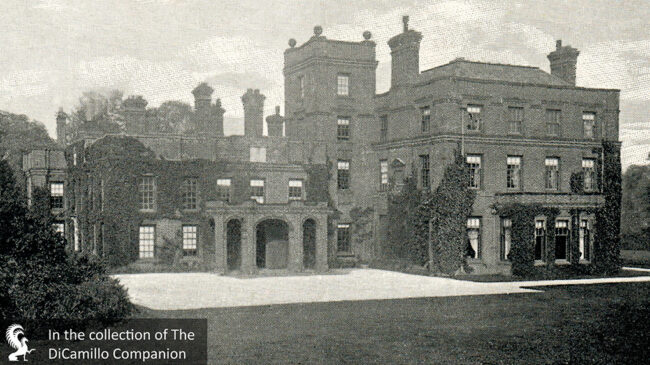
The House from a 1906 postcard
Built / Designed For: Hugh Pigot
House & Family History: Known as Papelau in the Domesday Book, the Peplow Estate was owned by Ralph de Mortimer after the Norman Conquest (Mortimer was forced to disgorge the Estate when he took part in a rebellion against William the Conqueror). During the 13th century the Estate was part of the nearby the Hodnet Estate, after which it passed to the De Ludlow and Vernon families. The Vernons were here until 1715, when Sir Richard Vernon sold the Peplow Estate to Hugh Pigot of Cheshire for £5,000 (approximately £9 million in 2016 inflation-adjusted values using the labour value commodity index). The current red brick house was built in 1725 by a later Hugh Pigot. By circa 1800 the Pigots had sold up for £45,000 to Thomas Clarke of Liverpool. At Clark's death Peplow was purchased by Arthur Clegg of Manchester for £60,000. It was Clegg's granddaughter, Anne, who inherited the estate; in 1831 Anne had married Rowland Hill, later Viscount Hill, from the great Shropshire estate of Hawkstone Hall. It was through this marriage that Peplow passed into the ownership of the Hill family. In 1873 Sir Francis Stanier, a wealthy industrialist, bought the Peplow Estate; in 1877 Stainer substantially enlarged the House (much of which work was demolished during the 1930s alterations). Stainer's son, Beville, later 1st Baronet Stanier, encountered financial difficulties because of the agricultural depression and put part of the 4,000-acre estate on the market. By the 1930s the agricultural estate had been reduced to 1,000 acres and the House substantially reduced in size. In April of 2014 Lord Newborough put Peplow Hall, together with the 681-acre estate, on the market at a guide price in excess of £12 million. Lord Newborough will continue to maintain and farm his two other estates, both in Wales: the 12,500-acre Rhug Estate in Denbighshire and the Glynllifon Estate in Gwynedd.
Garden & Outbuildings: Peplow has an unusual (still actively worked), curved-walled kitchen garden, one of the few in England. There is also a formal garden and an arboretum of specimen trees, including yews, ashes, wellingtonias, and oaks. Around the perimeter of the House are 10 let houses and cottages.
Architect: Richard Norman Shaw
Date: 1877House Listed: Grade II*
Park Listed: Not Listed
Current Seat / Home of: Robert Vaughan Wynn, 8th Baron Newborough; Wynn family here since 1974.
Past Seat / Home of: SEATED AT EARLIER HOUSE: Ralph de Mortimer, 11th century. de Ludlow family, 14th century? Vernon family, 14th century? Until 1715. SEATED AT CURRENT HOUSE: Hugh Pigot, 18th century; Pigot family here until circa 1800. Rowland Clegg-Hill, 3rd Viscount Hill, 19th century; Hill family here until 1873. Sir Francis Stanier, 19th century; Stainer family here from 1873 until the 1930s. Capt. William B. Higgin, mid-20th century.
Current Ownership Type: Individual / Family Trust
Primary Current Ownership Use: Private Home
House Open to Public: No
Historic Houses Member: No